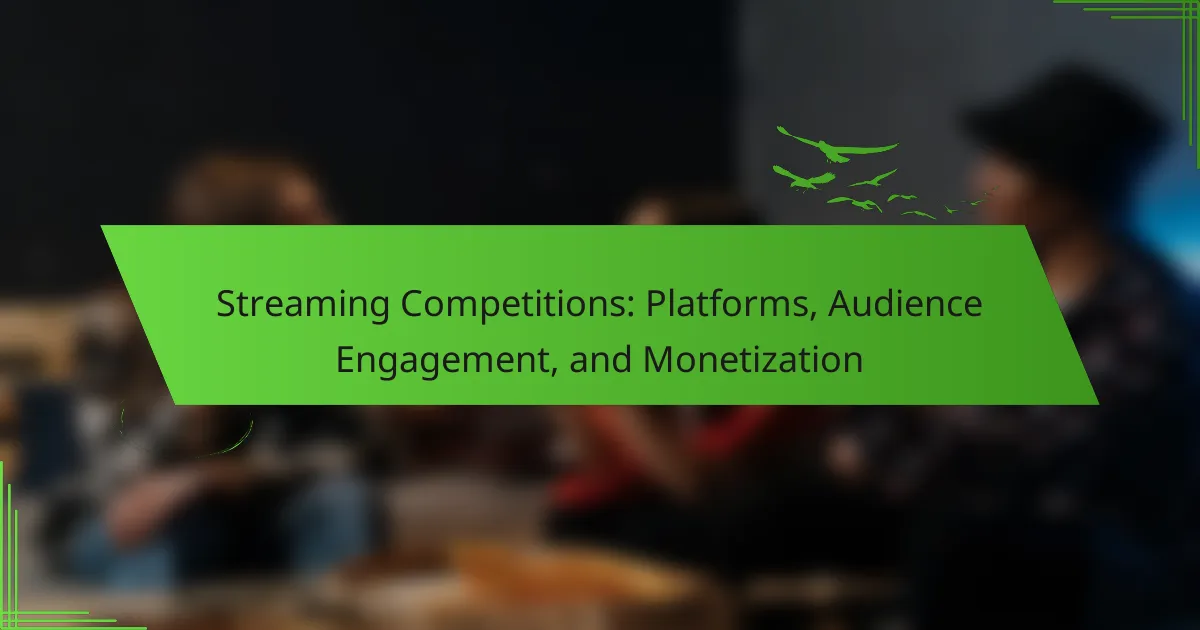Streaming competitions engage audiences through interactive features and community participation. Key platforms like Twitch, YouTube, and Facebook Gaming offer unique monetization strategies. Challenges include content differentiation and maintaining viewer interest. Understanding these dynamics is essential for successful streaming competition initiatives.
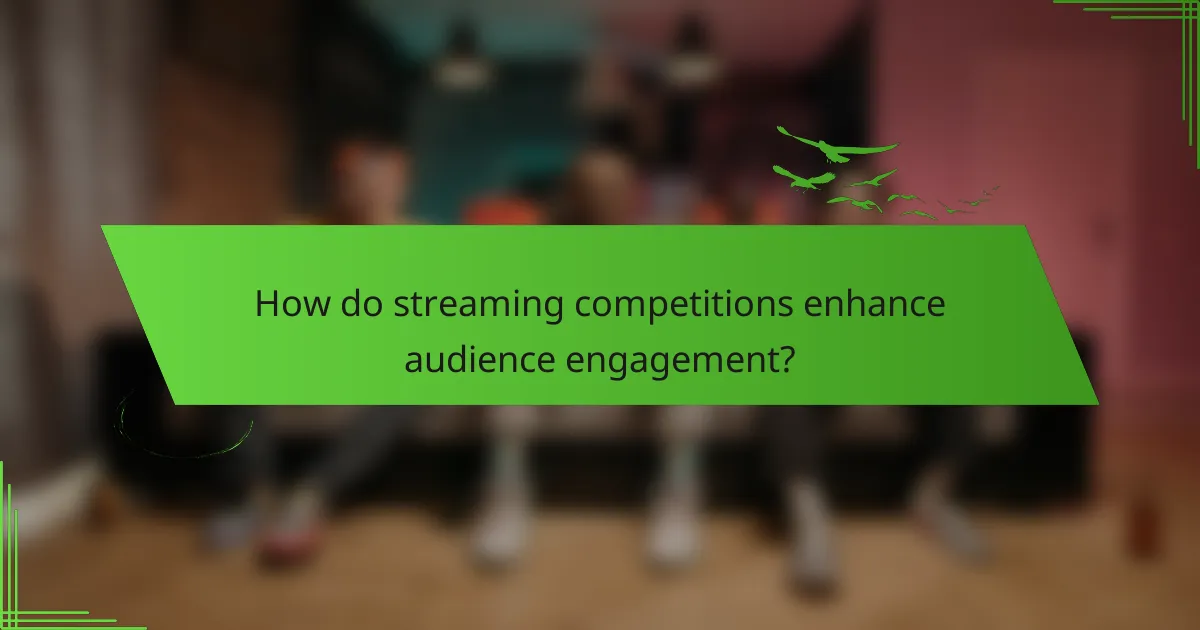
How do streaming competitions enhance audience engagement?
Streaming competitions significantly enhance audience engagement by fostering interactivity and community participation. Viewers become active participants through real-time voting and chat features, creating a sense of involvement. This engagement can lead to increased viewer retention and loyalty, as audiences feel connected to the competition and its participants. Additionally, platforms often incorporate gamification elements, such as rewards and leaderboards, which further incentivize audience interaction. As a result, streaming competitions not only entertain but also cultivate a vibrant community around shared interests.
What interactive features boost viewer participation?
Interactive features that boost viewer participation include live polls, real-time chat, and viewer challenges. These elements create a dynamic environment, encouraging audience interaction and enhancing engagement. For example, live polls allow viewers to influence outcomes, while real-time chat fosters community discussions. Additionally, viewer challenges can incentivize participation and increase loyalty, making the streaming experience more immersive and rewarding.
Which platforms excel in fostering community interaction?
Twitch, Discord, and YouTube excel in fostering community interaction. Twitch offers real-time chat and live streaming, enhancing viewer engagement. Discord provides dedicated servers for community building and interaction. YouTube combines comments, live chats, and community posts to connect creators with audiences.
How do cultural factors influence audience behavior in streaming competitions?
Cultural factors significantly influence audience behavior in streaming competitions by shaping preferences and engagement levels. Different cultures prioritize various aspects of entertainment, leading to diverse viewing habits. For instance, collectivist cultures may favor team competitions, while individualistic cultures might prefer solo performances. Additionally, cultural norms dictate interaction styles, affecting how audiences engage with content and each other during competitions. This results in varied monetization strategies, as platforms tailor offerings to align with cultural expectations and values.

What are the primary platforms for streaming competitions?
The primary platforms for streaming competitions include Twitch, YouTube, Facebook Gaming, and Mixer. Each platform offers unique features for audience engagement and monetization.
Twitch is the leading platform, known for its interactive chat and community features. YouTube provides extensive reach and monetization options through ads and memberships. Facebook Gaming integrates with social media for easy sharing and audience building. Mixer, although less popular, focused on low-latency streaming to enhance viewer experience.
These platforms cater to diverse audiences and support various competition formats, from esports to creative contests.
Which platforms dominate the streaming competition landscape?
Streaming platforms like Netflix, Amazon Prime Video, and Disney+ currently dominate the competition landscape. These platforms engage audiences through diverse content offerings and innovative monetization strategies. Netflix leads with over 230 million subscribers, leveraging original programming to retain viewers. Amazon Prime Video follows closely, integrating streaming with its e-commerce services, enhancing user experience. Disney+ capitalizes on its extensive library of beloved franchises, appealing to families and nostalgic audiences. Other platforms like Hulu and HBO Max continue to carve out niches with unique content and targeted demographics.
How do platform features differ across major streaming services?
Major streaming services differ in features such as content libraries, user interfaces, and monetization strategies. Netflix offers a vast library and ad-free experience, while Hulu combines subscription with ad-supported options. Amazon Prime Video provides additional benefits like shopping perks, and Disney+ focuses on exclusive family-friendly content. Each platform targets unique audience segments, influencing engagement and retention.
What role do regional platforms play in local streaming competitions?
Regional platforms significantly enhance local streaming competitions by providing tailored content and fostering community engagement. These platforms often cater to specific demographics, offering localized programming that resonates with regional audiences. As a result, they create a competitive edge by adapting to cultural preferences and trends.
Moreover, regional platforms typically utilize unique monetization strategies, such as subscription models or ad placements that align with local advertisers. This targeted approach not only boosts revenue but also strengthens viewer loyalty. By focusing on local content, these platforms can attract niche audiences, ultimately driving higher engagement rates compared to broader, national services.
In summary, regional platforms play a crucial role in the success of local streaming competitions by leveraging localized content and tailored monetization strategies. Their ability to connect with specific audiences enhances competition and stimulates growth within the streaming landscape.

How is monetization structured in streaming competitions?
Monetization in streaming competitions primarily relies on sponsorships, subscription models, and advertising revenue. Platforms like Twitch and YouTube offer creators opportunities to earn through viewer donations and merchandise sales. Sponsorship deals often provide significant funding, while ads generate ongoing income based on viewer engagement metrics. Unique attributes include exclusive content access for subscribers, which enhances audience loyalty and increases revenue potential.
What are the main revenue streams for streaming competition organizers?
Streaming competition organizers primarily generate revenue through sponsorships, advertising, subscription models, merchandise sales, ticket sales for live events, and crowdfunding. These revenue streams leverage audience engagement across various platforms, enhancing monetization opportunities. Sponsorships provide significant funding, while advertising captures additional revenue from brand partnerships. Subscription models offer consistent income, allowing fans to access exclusive content. Merchandise sales capitalize on brand loyalty, and ticket sales for live events create direct revenue from attendees. Crowdfunding allows fans to support their favorite competitions, providing another financial avenue.
How do sponsorships impact financial success in streaming competitions?
Sponsorships significantly enhance financial success in streaming competitions by providing essential funding and increasing visibility. They attract larger audiences and create additional revenue streams through brand partnerships. For example, major sponsors can elevate competition prestige, leading to higher viewer engagement and increased advertising revenue. The integration of sponsorships also allows for better production quality, further enhancing the viewer experience and audience retention.
What innovative monetization strategies are emerging in 2025?
In 2025, innovative monetization strategies in streaming competitions focus on interactive audience engagement and diversified revenue streams. Platforms leverage real-time voting, subscription models, and exclusive content to enhance viewer participation and loyalty.
For example, platforms may introduce tiered subscriptions offering unique perks, such as backstage access or personalized experiences. Additionally, integrating gamification elements encourages audience involvement, driving up revenue through in-app purchases and sponsorship deals.
Data indicates that platforms utilizing these strategies see increased viewer retention rates, with some reporting up to 30% growth in subscriber numbers. As a result, the monetization landscape is evolving to prioritize community-driven experiences, ensuring sustained engagement and profitability.
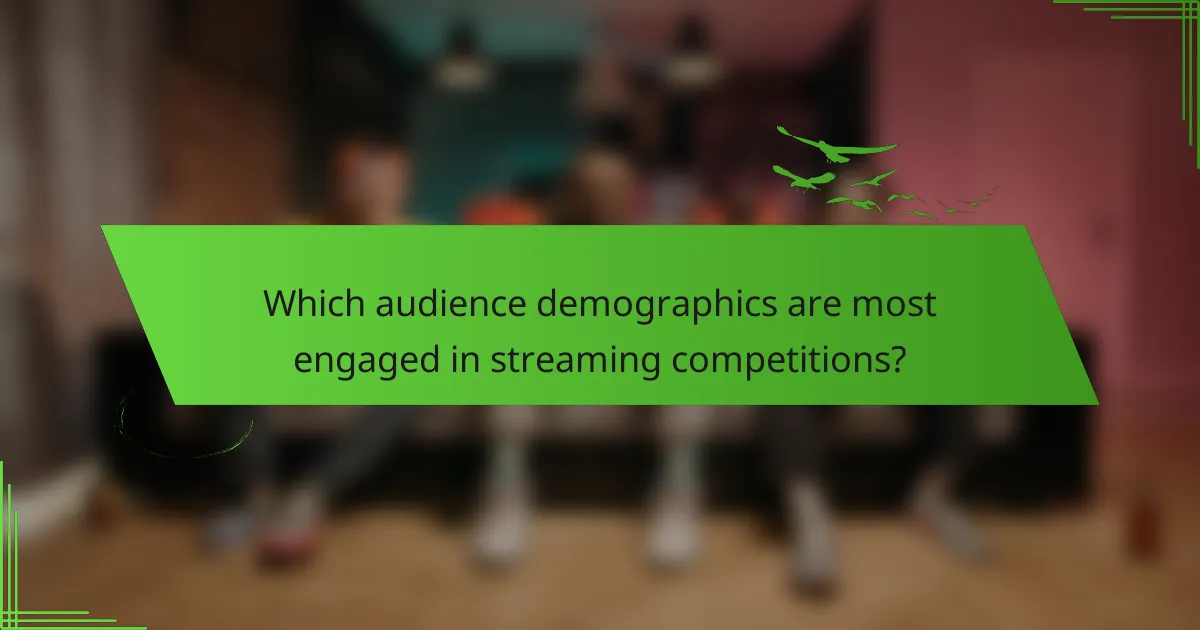
Which audience demographics are most engaged in streaming competitions?
The most engaged audience demographics in streaming competitions are primarily young adults aged 18-34. This group represents a significant portion of viewers, driven by their interest in gaming and interactive content. Additionally, both male and female audiences show increasing participation, with males slightly dominating the viewer base. Geographically, urban areas exhibit higher engagement levels due to better internet access and technology adoption.
How do age and gender influence participation rates?
Age and gender significantly influence participation rates in streaming competitions. Younger audiences, particularly males, tend to engage more actively on platforms like Twitch. This demographic shows higher levels of interaction and content creation. Conversely, older age groups and females often participate less, affecting overall engagement metrics. For instance, studies indicate that participants aged 18-24 represent over 50% of active users on major streaming platforms. Gender dynamics also play a role, with male participants dominating in competitive gaming streams, while female audiences gravitate towards lifestyle and creative content.
What motivates different demographics to engage with streaming competitions?
Different demographics engage with streaming competitions due to a mix of entertainment, community, and potential rewards. Younger audiences often seek social interaction and excitement, while older viewers may focus on skill and strategy appreciation.
Millennials and Gen Z are particularly motivated by the interactive elements, such as live chats and viewer participation, enhancing their connection to the content. In contrast, Gen X and Baby Boomers often engage for the competitive aspects, valuing the skill displayed by participants.
Monetization opportunities also attract diverse audiences. For example, gamers may be drawn to platforms that offer cash prizes or sponsorship deals. This financial incentive can significantly influence participation across various age groups.
Cultural factors also play a role, as different regions may prioritize specific genres or types of competitions, shaping viewer preferences and engagement levels.
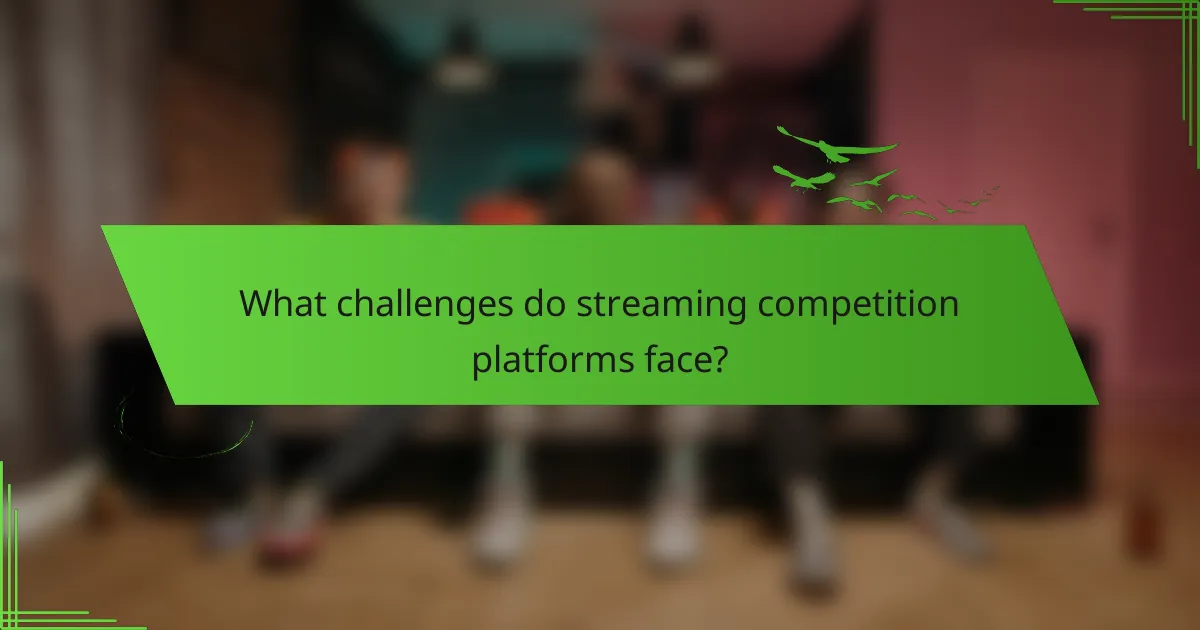
What challenges do streaming competition platforms face?
Streaming competition platforms face significant challenges in audience engagement, content differentiation, and monetization strategies. Intense competition leads to content saturation, making it difficult for platforms to stand out. Additionally, maintaining viewer interest requires innovative engagement techniques, such as interactive features and personalized recommendations. Monetization poses another hurdle, as platforms must balance subscription models with ad revenue without compromising user experience. These factors contribute to the ongoing struggle for platforms to achieve sustainable growth and profitability in a crowded market.
How do technical issues affect viewer experience and retention?
Technical issues significantly diminish viewer experience and retention. Buffering, lag, and poor video quality frustrate users, leading to increased drop-off rates. For instance, studies show that a mere two seconds of buffering can cause a 30% decrease in viewer retention. Additionally, inconsistent streaming quality can reduce audience engagement, as viewers may abandon platforms that fail to deliver a seamless experience. Improving technical reliability is crucial for platforms aiming to enhance audience satisfaction and maximize monetization opportunities.
What are the common legal challenges related to streaming competitions?
Streaming competitions face several common legal challenges, including copyright infringement, licensing issues, and compliance with broadcasting regulations. These challenges arise from the need to use copyrighted content, such as music and game footage, which requires proper licensing agreements. Additionally, platforms must navigate varying laws regarding viewer privacy and data protection, which can differ significantly by region. As a result, legal counsel is essential for ensuring compliance and minimizing risks associated with streaming competitions.

How do unique attributes shape the success of specific competitions?
Unique attributes significantly enhance the success of streaming competitions by attracting targeted audiences and fostering engagement. These competitions thrive on distinct features like interactive formats, exclusive content access, and innovative monetization strategies. For instance, platforms that offer real-time audience participation create a sense of community, encouraging higher viewer retention. Unique attributes such as gamification elements and personalized viewer experiences lead to increased loyalty and participation rates. Ultimately, these factors contribute to the overall effectiveness and appeal of streaming competitions, driving both audience growth and revenue generation.
What differentiates successful competitions from less popular ones?
Successful streaming competitions engage audiences effectively and utilize diverse monetization strategies. Key factors include platform selection, interactive features, and community involvement. High-quality production values and consistent scheduling also enhance viewer retention. Unique attributes, such as exclusive content and influencer participation, further differentiate successful competitions from less popular ones.
How do niche competitions cater to specific audience interests?
Niche competitions effectively cater to specific audience interests by tailoring content and engagement strategies. They focus on unique themes, enabling deeper connections with participants. This personalization enhances viewer loyalty and drives monetization through targeted advertising and sponsorships. Platforms often analyze audience data to refine offerings and improve user experience.
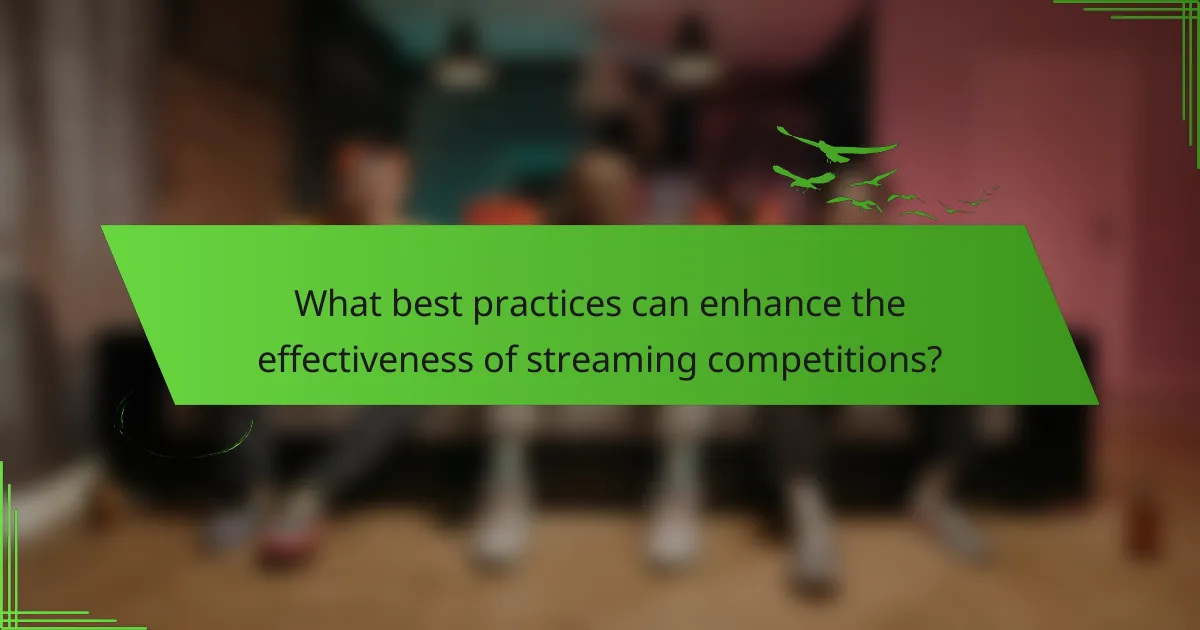
What best practices can enhance the effectiveness of streaming competitions?
To enhance the effectiveness of streaming competitions, focus on audience engagement, interactive features, and strategic monetization. Engaging viewers through real-time polls, chat interactions, and gamification keeps them invested. Utilize multiple platforms to reach diverse audiences, maximizing visibility. Monetization strategies like sponsorships, merchandise sales, and subscription models can generate revenue while fostering community. Consistent feedback loops improve future events, aligning with audience preferences.
Which strategies optimize viewer retention and engagement?
Engaging viewers and retaining their attention in streaming competitions requires targeted strategies. Key tactics include interactive features, personalized content, and regular community engagement.
1. Incorporate live polls and Q&A sessions to foster real-time interaction.
2. Utilize data analytics to tailor content based on viewer preferences.
3. Host regular events and competitions to build a loyal community.
4. Offer exclusive behind-the-scenes content to enhance viewer connection.
5. Implement gamification elements to encourage participation and retention.
6. Leverage social media for cross-platform engagement and promotion.
What common mistakes should organizers avoid in streaming competitions?
Organizers should avoid common mistakes such as neglecting audience interaction, failing to test technology beforehand, underestimating promotion, and not having a clear schedule. Engaging the audience is crucial for retention. Technical issues can disrupt the experience, so testing equipment and software is essential. Effective promotion ensures a larger viewership, while a clear schedule helps maintain organization. These practices enhance the overall quality of streaming competitions.
